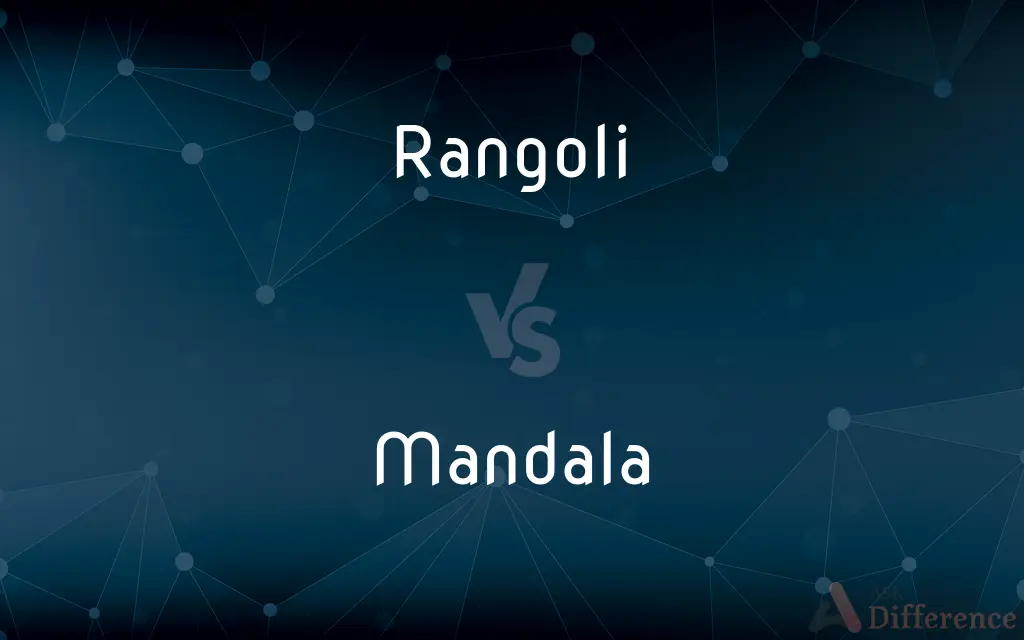Rangoli vs. Mandala — What's the Difference?
By Tayyaba Rehman & Urooj Arif — Updated on March 31, 2024
Rangoli, a traditional Indian art form, involves creating patterns on the ground using materials like colored rice and flowers, while Mandalas are spiritual symbols in Hinduism and Buddhism, representing the universe in intricate designs.

Difference Between Rangoli and Mandala
Table of Contents
ADVERTISEMENT
Key Differences
Rangoli is an ephemeral art form traditionally practiced in India, where designs are created on the floor using colored rice, dry flour, colored sand, or flower petals, often during festivals like Diwali or Onam. In contrast, mandalas are geometric configurations of symbols that are deeply rooted in Hindu and Buddhist traditions, often used as tools for meditation and rituals and are not limited to a specific material or temporary setting.
The creation of Rangoli is typically a communal activity that brings people together during celebratory occasions, emphasizing its cultural and social significance in Indian society. Mandalas, on the other hand, while they can be created as a group activity, are primarily used for spiritual and meditational purposes, focusing on individual introspection and the quest for inner peace.
Rangoli designs are often passed down through generations, with patterns that are symbolic of traditions, folklore, and practices specific to different regions of India. Mandalas, however, are more universally recognized in their symbolism, depicting the complexities of the universe and life, transcending cultural and geographical boundaries.
The aesthetics of Rangoli emphasize colorfulness and vibrant patterns, which celebrate life, joy, and auspiciousness. Mandalas, while also intricate and beautiful, serve a deeper purpose of illustrating spiritual truths and cosmic order, often incorporating specific symbols and geometry that carry specific meanings within Hindu and Buddhist cosmologies.
While both Rangoli and Mandalas can serve as objects of contemplation, the former is more about celebrating the present moment and the beauty of impermanence. Mandalas, conversely, invite a deeper exploration of the self and the universe, often leading to a meditative practice that can facilitate spiritual growth and enlightenment.
ADVERTISEMENT
Comparison Chart
Origin
Indian subcontinent
Hinduism and Buddhism
Purpose
Decorative, celebratory
Meditation, spiritual
Materials Used
Colored rice, sand, flowers
Sand, paint, thread, etc.
Duration
Temporary, often remade for occasions
Can be permanent or temporary
Symbolism
Auspiciousness, social and cultural values
Universe, inner peace, enlightenment
Creation Process
Communal, often spontaneous
Individual or group, meditative
Design
Geometric and floral patterns, colorful
Intricate geometric patterns, symbolic
Compare with Definitions
Rangoli
Utilizes natural or synthetic colored materials.
She used colored rice and petals to make the rangoli.
Mandala
Often temporary, symbolizing the transitory nature of life.
After the ceremony, the sand mandala was ceremoniously destroyed.
Rangoli
Represents traditions and practices of India.
Each rangoli pattern passed down through generations tells a story.
Mandala
A spiritual and ritual symbol in Hinduism and Buddhism.
The monk created a sand mandala as a meditation on impermanence.
Rangoli
A traditional Indian art form of creating patterns on the ground.
For Diwali, they decorated their home with a colorful rangoli.
Mandala
Represents the universe and spiritual journey.
Each part of the mandala symbolizes a step towards enlightenment.
Rangoli
Celebrates the beauty of the moment.
Though the rangoli faded, its joy and spirit lingered.
Mandala
Used in spiritual practice and meditation.
In the meditation center, a mandala served as a focal point for contemplation.
Rangoli
Made during festivals and auspicious events.
The courtyard was adorned with rangoli for the wedding.
Mandala
Can be created with a variety of materials.
She painted a mandala using vibrant hues on canvas.
Rangoli
Rangoli is an art form originating in the Indian subcontinent, in which patterns are created on the floor or a tabletop using materials such as powdered lime stone, red ochre, dry rice flour, coloured sand, quartz powder, flower petals, and coloured rocks. It is an everyday practice in Hindu households, however the colours are preferred during festivals and other important celebrations as it is time consuming.
Mandala
A mandala (Sanskrit: मण्डल, romanized: maṇḍala, lit. 'circle', [ˈmɐɳɖɐlɐ]) is a geometric configuration of symbols. In various spiritual traditions, mandalas may be employed for focusing attention of practitioners and adepts, as a spiritual guidance tool, for establishing a sacred space and as an aid to meditation and trance induction.
Rangoli
(India) A geometric or stylized design on the floor (or other flat surface) made using small coloured granules or powder.
Mandala
Any of various ritualistic geometric designs symbolic of the universe, used in Hinduism and Buddhism as an aid to meditation.
Mandala
A graphic depiction of the spiritual universe and its myriad realms and deities.
Mandala
Any ritualistic geometric design, symbolic of the Universe, used as an aid to meditation.
Mandala
A division or book of the Rigveda (of which there are 10).
Mandala
Any of various geometric designs (usually circular) symbolizing the universe; used chiefly in Hinduism and Buddhism as an aid to meditation
Common Curiosities
What is the main purpose of creating a rangoli?
The main purpose is decorative and celebratory, reflecting joy, auspiciousness, and cultural values.
Do you need special materials to create a mandala?
No, mandalas can be created with a wide range of materials, including sand, paint, and even digital tools.
Can mandalas be used outside of religious contexts?
Yes, mandalas are also used for therapy and relaxation, appreciated for their aesthetic and meditative qualities.
Is it difficult to learn how to make a rangoli?
Learning the basic patterns can be simple, but creating intricate designs requires practice and skill.
Are there specific occasions for making rangoli?
Yes, rangoli is often made during Indian festivals like Diwali, Pongal, and Onam, as well as weddings and other celebrations.
Can anyone make a rangoli or a mandala?
Yes, both art forms are accessible to anyone, though they carry deep cultural and spiritual significance in their original contexts.
Can creating mandalas be considered a form of meditation?
Yes, the process of creating mandalas is often used as a meditative practice to focus the mind and encourage inner peace.
What does the destruction of a sand mandala symbolize?
The dismantling of a sand mandala symbolizes the Buddhist concept of impermanence and the transient nature of life.
How can I preserve a rangoli?
Rangoli is inherently temporary, but its design can be preserved through photography or by using semi-permanent materials.
Can rangoli designs be abstract?
Yes, while many rangoli designs are symbolic and traditional, abstract designs are also popular.
How long does it take to create a mandala?
It varies; some mandalas can be created in a few hours, while others, especially large sand mandalas, may take days.
Is it okay to walk on rangoli?
Generally, rangoli is made in areas where it's understood that they may be walked over, though some may be placed in less trafficked areas to preserve them longer.
Are there digital tools for making rangoli or mandalas?
Yes, there are digital applications and software that allow for the creation of rangoli and mandala designs.
Do the colors in a mandala have specific meanings?
Yes, colors in mandalas can represent various elements and spiritual concepts, such as wisdom, compassion, and healing.
Are mandalas always circular?
While the circle is a dominant motif, mandalas can also incorporate other geometric shapes within their design.
Share Your Discovery

Previous Comparison
Cellphone vs. Smartphone
Next Comparison
Ear vs. LugAuthor Spotlight
Written by
Tayyaba RehmanTayyaba Rehman is a distinguished writer, currently serving as a primary contributor to askdifference.com. As a researcher in semantics and etymology, Tayyaba's passion for the complexity of languages and their distinctions has found a perfect home on the platform. Tayyaba delves into the intricacies of language, distinguishing between commonly confused words and phrases, thereby providing clarity for readers worldwide.
Co-written by
Urooj ArifUrooj is a skilled content writer at Ask Difference, known for her exceptional ability to simplify complex topics into engaging and informative content. With a passion for research and a flair for clear, concise writing, she consistently delivers articles that resonate with our diverse audience.














































